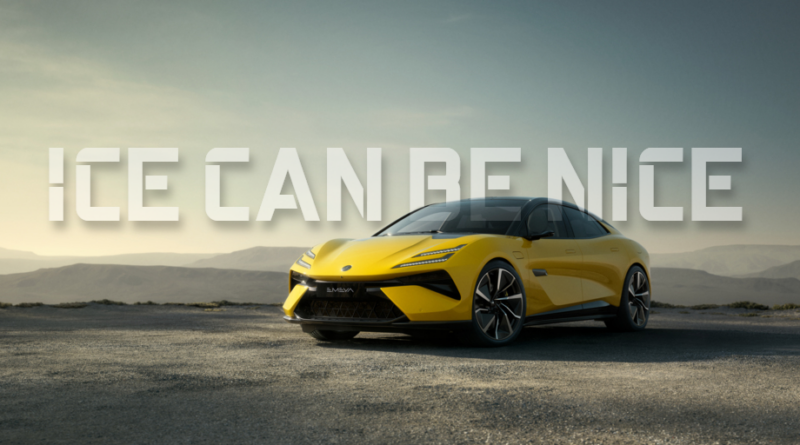Does The New Lotus Emeya Prove Electric Isn’t Always Better?
Support CleanTechnica's work through a Substack subscription or on Stripe.
Last week, Lotus Cars revealed its first four-door hyper-GT since the Lotus Carlton in a move that it says is, “bringing together our rich heritage with intelligent performance and the latest cutting-edge technologies, we’re pushing the boundaries for how a luxury electric vehicle should look and handle — making it truly for the drivers,” according Feng Qingfeng, CEO, Lotus Group. The car itself is an absolute stunner — with proper proportions, a suitably sporty look, an electronically controlled “active” suspension system, and (of course) 905 fully electrified horsepower.
As a hyper-GT, the new Lotus Emeya is nearly perfect. But, like the 2000 HP Lotus Evija before it, it begs the question: should this have been an internal-combustion car, after all?
Nope, It’s Still Me

Lest you think I’ve been replaced by some kind of alien replicant or Stepford robot, this is, in fact, Jo Borrás — long-time proponent of sustainable fuels and electrification, champion of urban micromobility, and general friend of the planet. Why, then, am I complaining about a storied brand like Lotus rolling out a 900 HP super-sedan that’s 100% electric? I’m glad you asked!
See, the issue is the carbon cost of manufacturing something like the Emeya. Back in 2021, a Reuters analysis of data from a model developed by the Argonne National Laboratory in Chicago that includes thousands of parameters from the type of metals in an electric vehicle (EV) battery to the amount of aluminum or plastic in a car found that a Tesla Model 3 owner would have to drive some 13,500 miles before they’d start to be “greener” than a comparable internal combustion sedan.
That’s a Tesla Model 3. Not only one of the most efficient vehicles to drive ever built, but one of the most efficient vehicles to build, as well.
The Lotus? Let’s assume that it’s not, in part because of its rarity, in part because of the advanced composites used in its construction, and in part because it’s built to maximize performance and cornering, with all the sacrifices to efficiency that wide, grippy tires, and downforce-generating bodywork bring with them.
Given all that, I think it’s fair to assume that the Lotus might need (and, to be clear, this is all wild conjecture) something closer to 40,000 miles of driving to get ahead of that same internal combustion version, and you see the problem: what Lotus have you seen that’s been driven 40,000 miles!?
This is mostly anecdotal, purely opinion-driven, and generally tinged with nostalgia, but the Lotuses (Lotii?) that interest me, the Peter Stevens-designed 2nd-gen Esprit and M100 Elán, as well as the aforementioned Omega/Carlton, generally don’t have that many miles on them. Look at this screencap …

… even some of the later cars I’ve stumbled across at track days and Cars and Coffee events, the Elise and Exige models all seem to be barely used automotive oddities, with only one such car (a 2010 Exige) boasting more than 40,000 driven miles.
These are toys, in other words. Lightweight, tossable toys that grown men abuse wickedly on weekends — but not “real cars.”
The Evija, with its massive 2000 HP motors and centrally-located batteries, is the same type of automotive toy, albeit a bit more serious in its sporting capabilities. And that car is terrific marketing for EVs. “Look on, ye ICE-y snowflakes, with your pathetic Hemis and Blower Benzes, and shiver in fear! The electrics are here!” It serves that purpose, and delivers on the Lotus brand’s F1 and IMSA racing heritage.
The Emeya?
It’s pretty, but it’s far too heavy to feel anything like a Lotus 7 or Elan or Esprit. It’s not sporty enough to shame the likes of the Tesla Model S Plaid or Lucid Air Sapphire. Instead, it’s just kind of a fast sedan with a premium price tag … and one that, if anyone buys it, very likely won’t ever see north of 30,000 miles, let alone 40 or 50.
I’m willing to question whether or not this kind of vehicle should be allowed to exist at all, but I’m pretty well convinced that if you’re building something for extremely limited use in an extremely limited market, something like the Porsche/Bosch Syngas or Toyota Hydrogen combustion solutions may be the better way forward. That’s just me, though — what do you guys think? Scroll on down to the comments section at let us know.
The Pretty New Lotus Emeya







Sign up for CleanTechnica's Weekly Substack for Zach and Scott's in-depth analyses and high level summaries, sign up for our daily newsletter, and follow us on Google News!
Have a tip for CleanTechnica? Want to advertise? Want to suggest a guest for our CleanTech Talk podcast? Contact us here.
Sign up for our daily newsletter for 15 new cleantech stories a day. Or sign up for our weekly one on top stories of the week if daily is too frequent.
CleanTechnica uses affiliate links. See our policy here.
CleanTechnica's Comment Policy

